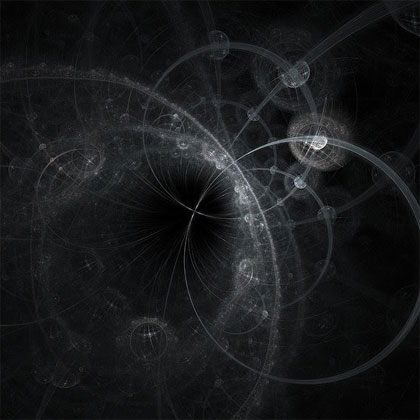
You Might be Immortal: The Weird World of Quantum Immortality
Brent Swancer January 28, 2022
Since time unremembered there have been those who have sought immortality, to live forever and to cheat death. This has always been a pursuit involving all manner of ways to try and stop our physical body from dying or to prolong our biological life, but what if all of this is unnecessary and we are already immortal and don’t even know it? As we delve into the mysteries of the universe and our reality we have gone further down a rabbit hole of strange natural phenomena, and chief among these is that of quantum physics. It is a spooky world underlying everything we do and all that we see, where traditional normal and predicted laws of physics don’t seem to really apply and which we know barely anything about. It is a realm of speculation, debate, and few solid answers, and it just might hold the key to you being immortal.
A man sits in a room with a gun pointed at his head. The gun is rigged to a machine that measures the spin of a quantum particle and it is loaded with live rounds, pointed directly at his head in such a way that it will kill him instantly if it goes off. The man takes a deep breath, understandably nervous because there is a loaded gun pointed at his head, but he is determined to go through with the experiment he is involved in. In his trembling hand is a device with a button that he can push to fire the gun, his thumb hovering over it as he contemplates what is about to happen. He takes a deep breath and pushes the button. The gun goes “click.” That’s strange, he thinks, is there something wrong with it or the ammunition? He pushes it again, then again and again. Click, click, click. Nothing. Meanwhile, in the next reality over, his colleagues are watching his head get blown off and he is quite dead. Welcome to the world of quantum immortality.
The above is a thought experiment designed in 1997 by then-Princeton University theorist Max Tegmark in order to explore ideas and navigate the very weird world of quantum mechanics. In this case, the experiment hinged on the idea in quantum physics that quantum particles, called quarks, the smallest level of matter we’ve detected so far in the universe, exist in multiple states all at once, called superposition of states, before being measured, when they become a single state. This means that they are existing in all states of matter and spinning clockwise and counterclockwise simultaneously, even in two places at once, only snapping into one variation upon being observed, collapsing all of these possible states down into one, the one that is being measured and observed. It is much more complicated than this, but that is the gist. The idea behind Tegmark’s thought experiment was that while we see only one measurement of the particle, all other possibilities still exist in another universe, so for instance, whereas in this universe the particle is seen spinning clockwise, in another branch of reality it is being observed spinning counterclockwise and so on. Wait, what? Let me explain.
 Tegmark was playing with the idea that these quantum states of superposition lead to what is called the Many-worlds interpretation, in which every possibility and every outcome of every decision anyone has ever made splits off to a new reality where that has happened. In one reality you wore a blue shirt today instead of a red one, in another the Germans won World War II, or dinosaurs never went extinct, and so on, with infinite variations. All possibilities become a reality because the universe and reality exists in all states at once, branching out to accommodate all other possibilities, then that is translated from the quantum world to the macro where we live, therefore multiple separate realities exist out there that individually possess all the possibilities. According to the Many-worlds interpretation, every choice you make, every event that happens, every possible outcome splits off into a new branch of reality, with observers unaware of the other realities all around them, only the one they can perceive and consciously bear witness to.
Tegmark was playing with the idea that these quantum states of superposition lead to what is called the Many-worlds interpretation, in which every possibility and every outcome of every decision anyone has ever made splits off to a new reality where that has happened. In one reality you wore a blue shirt today instead of a red one, in another the Germans won World War II, or dinosaurs never went extinct, and so on, with infinite variations. All possibilities become a reality because the universe and reality exists in all states at once, branching out to accommodate all other possibilities, then that is translated from the quantum world to the macro where we live, therefore multiple separate realities exist out there that individually possess all the possibilities. According to the Many-worlds interpretation, every choice you make, every event that happens, every possible outcome splits off into a new branch of reality, with observers unaware of the other realities all around them, only the one they can perceive and consciously bear witness to.
In relation to this particular thought experiment, which is known as the Quantum Suicide experiment, the man in the room pulls the trigger of the gun and there are two possible outcomes. It either goes off and kills him instantly, or it misfires and he lives on to see another day. When the trigger is pulled, both possibilities happen at the same time, creating a branch of two realities, one in which he dies, and one in which he lives. Since the subject must be conscious to perceive the way that things go, he therefore can only consciously exist in the reality in which he has not died. Now to be clear, he has died in one reality, where observers saw the gun shoot him. He will be mourned and he will be gone in that timeline, but the subject himself will not be aware of that. To him the gun simply clicked instead of firing and life goes on in his new branch of reality, because only one of the two experimenter superpositions – the one who lived – is capable of having any sort of conscious experience of it. To him he was just really lucky. In this scenario he will never die in the reality that he is observing, essentially making him immortal without even realizing it.
This is quantum immortality in a nutshell.
This version of the Many-worlds theory in relation to immortality goes all the way back to 1957, when the idea was tossed around by a doctoral student at Princeton University named Hugh Everett III, who proposed that consciousness is bound at each branching of realities to follow whatever path does not lead to death. It was this idea that was picked up by Tegmark and made into the Quantum Suicide thought experiment and the notion that we are all essentially immortal. In another example, imagine if you will that you are crossing a street. You look both ways, see that everything is clear, then start to walk across. Out of nowhere a car comes speeding around the corner to come barreling right at you while shocked bystanders stare on. However, you think quick and you are able dodge out of the way just in time, narrowly escaping certain death. However, for those watching in one version of events, they are treated to the horrific sight of you being hit by the car, running you over and killing you. In their observable reality you are dead, but in your branch it was just a scary experience. This will happen no matter how many times death comes for you. There is always a universe where you will narrowly escape death, with any brush with mortality seeing a branching universe, so while in one version one of you dies, another always continues to live on. Hungarian philosopher István Aranyosi would put it succinctly when he said, “Since the number of such increasingly improbable survival branches is infinite, given that the probability of surviving never drops to zero, we should expect to live forever. This is what we call Quantum Immortality.”
 This is not much consolation to those you left behind, because for them you are dead, but in your observable universe you are effectively immortal. According to this theory, this applies not only to death, but to anything, any decision you make and anything that happens to you, the universe splitting to accommodate each and every possible outcome. You won the lottery in one and did not in another, in one you ate the beef instead of the chicken, while the other you had the chicken, and so on. The thing is, each branch of you is unaware of the others, all going on through your immortal life without ever realizing that the other possibilities have happened to another you. It is a fun idea to play around with, all sorts of questions and scenarios to turn over in the mind. It could be why some people are considered really lucky, and what if those cases of sole survivors of disasters or those who have seemingly miraculously escaped death are us just being in the one reality where everything happened in just such a way that they survived? Maybe in addition to us branching off into new dimensions in which we didn’t die, we are receiving the same sorts of people from others. It really boggles the mind and has infinite possibilities and scenarios.
This is not much consolation to those you left behind, because for them you are dead, but in your observable universe you are effectively immortal. According to this theory, this applies not only to death, but to anything, any decision you make and anything that happens to you, the universe splitting to accommodate each and every possible outcome. You won the lottery in one and did not in another, in one you ate the beef instead of the chicken, while the other you had the chicken, and so on. The thing is, each branch of you is unaware of the others, all going on through your immortal life without ever realizing that the other possibilities have happened to another you. It is a fun idea to play around with, all sorts of questions and scenarios to turn over in the mind. It could be why some people are considered really lucky, and what if those cases of sole survivors of disasters or those who have seemingly miraculously escaped death are us just being in the one reality where everything happened in just such a way that they survived? Maybe in addition to us branching off into new dimensions in which we didn’t die, we are receiving the same sorts of people from others. It really boggles the mind and has infinite possibilities and scenarios.
Of course there are plenty of holes in this hypothesis, and much criticism. Perhaps most obvious is what happens when you grow old and die? Humans have a finite biological lifespan, so how could you just keep branching away from that inevitable fate? The same could be said for any degenerative disease or fatal condition, such as cancer. Also, what if you were only rendered brain dead but yet technically still alive? You likely wouldn’t feel like a survivor in that scenario. And why must we shift over to a reality in which we are unscathed? What if you were hit by that car and died, but brought into a reality just before you died, only to do it again and again, merely shifting to a universe where you are almost dead to repeat dying on an endless loop? After all, if you quickly die bleeding out on the street, how could any sequence of events save you in any reality? This is all tied to another problem with the thought experiment in that death is not always a binary, instantaneous event. Rather, it is usually a progressive process rather than a sudden affair, with a continuum of states of decreasing consciousness that makes the definition of “fully alive” and “fully dead” murky. The quantum suicide thought experiment relies on an abrupt transition between one and another, and so it is only within this one specific imaginary scenario of very exact requirements that a person finds themselves surviving. Of course there is the argument that in your branch of reality something always manages to stave off this gradual decline, be that some medical miracle or miraculous technology, but even Tegmark has acknowledged this criticism, and said:
Our consciousness is not located at one unique point in the brain, but is presumably a kind of emergent or holistic property of a sufficiently large group of neurons. Our consciousness might not be able to go out like a light, but it can dwindle exponentially until it is, for all practical purposes, gone.
Cosmologist Anthony Aguirre has added to this criticism of quantum immortality by also arguing that not only does death often exist on a spectrum, but also that it would ignore other states that are not death, but which render the subject unconscious to the world. He says:
Perhaps reality actually is this bizarre, and we really do subjectively ‘survive’ any form of death that is both instantaneous and binary. If there are degrees of survival, things are quite different. If loss of consciousness was binary like in the thought experiment, the quantum suicide effect would prevent an observer from subjectively falling asleep or undergoing anesthesia, conditions in which mental activities are greatly diminished but not altogether abolished. Consequently, upon most causes of death, even outwardly sudden, if the quantum suicide effect holds true an observer is more likely to progressively slip into an attenuated state of consciousness, rather than remain fully awake by some very improbable means.
 Similarly, there is the conundrum that in certain circumstances when death was not instantaneous there would be the paradox that several versions of you would exist in the same moment, and only one of you would go on. Philosopher of science Charles Sebens has said of this:
Similarly, there is the conundrum that in certain circumstances when death was not instantaneous there would be the paradox that several versions of you would exist in the same moment, and only one of you would go on. Philosopher of science Charles Sebens has said of this:
It is tempting to think you should expect survival with certainty. If death is indeed immediate on all branches but one, the thought (quantum immortality) has some plausibility. But if there is any delay it should be rejected. In such a case, there is a short period of time when there are multiple copies of you, each effectively causally isolated from the others and able to assign a credence to being the one who will live. Only one will survive. Surely rationality does not compel you to be maximally optimistic in such a scenario. Do the copies need to last long enough to have thoughts to cause trouble? I think not. If you survive, you can consider what credences you should have assigned during the short period after splitting when you coexisted with the other copies.
Yet another problem is who is really the real you among all of these copies? If there are so many variants of you, which would become distinct individuals when the reality branched, then how could you pick out some future versions of oneself as “really you” over others? There are numerous other objections and criticism to the idea of quantum immortality, to the point that even proponents of the Many-worlds interpretation find it hard to swallow. However, this is quantum physics we are talking about, a relatively new discipline that we know little about, which has generally freaked out physicists and of which physicist Richard Feynman once said, “I think it’s safe to say that nobody understands quantum mechanics.” It is also impossible to even attempt to test much of quantum physics in laboratory conditions with our current technology, relegating most of this to the realm of theorizing, philosophizing, and concocting thought experiments, so who knows? The realm of quantum physics is largely the domain of the unknown, with even quantum physicists arguing and contradicting each other, so it really seems that anything is possible. In this case it seems we may never know, because anyone who was to try the experiment and succeed would be the only one who knew about it, and even they would think it was just a fluke, while to their friends and family they would just be dead. For now the idea of quantum immortality is nothing more than another of the many ideas about quantum physics being thrown at the wall in an effort to see what sticks, another oddity in a sea of weirdness we may never truly unravel and were perhaps not meant to. In the meantime, it might be a good idea to hold off on trying this experiment out for yourself.
MU*




















